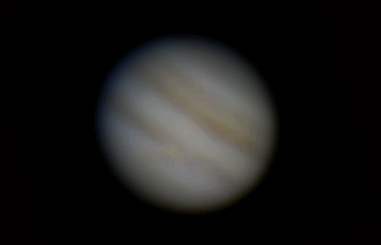
Imaging: NGC1275 Galaxy, Jupiter, Asteroid Vesta
Posted: 15 October 2012
The observatory was opened Sunday, 14 October 2012, at 2048 MST, 68°F. The sky was clear. First observed was the Double Cluster at 2055 MST, 77X. I then switched to a 40mm (50X), which provided a nice view of both clusters in the same FOV. I then used 133X to study each cluster individually. Next, I spent some time studying the galaxies M31, M32, and M110 in Andromeda, 133X. I then viewed Comet 168P/Hergenrother, 133X; still a nice comet to view, especially using averted vision. I then viewed M45, the Pleiades, 133X and 77X.
Beginning at 2129 MST, I did a tour of DSOs in Perseus, 77X: M76 (Little Dumbbell Nebula), Double Cluster, M34 (open cluster), NGC1245 (open cluster), NGC1275 (irregular galaxy), NGC1342 (open cluster), IC348 (diffuse nebula), NGC1499 (California Nebula), and NGC1528 (open cluster). I then returned to NGC1275 (irregular galaxy), as I planned to image it. I SYNCed the AutoStar on its location. I then began preparing the D7000 DSLR for 8" prime focus imaging using the Off-Axis Guider.
At 2200 MST, did a focus test on Alpha Perseus using the Bahtinov Mask, followed by a framing test exposure of NGC1275. I located a good guide star. This is a full-frame, guided, 5 minute, ISO 6400, exposure:

When I previewed the image on the D7000 DSLR, I noticed right away that many other galaxies had been captured. During post-processing, I discovered even more galaxies had been captured over much of the image Field-of-View. NGC1275 is the large galaxy left of center. This screen capture from SkySafari Pro for Mac OS X identifies the other galaxies captured:

I ended DSO imaging at 2215 MST, removed the camera and switched from the OAG to the eyepiece projection adapter with a 9mm eyepiece (222X). At 2230 MST, viewed Jupiter, 77X. The four Galilean Moons were visible. At 133X, the Great Red Spot was obvious, although it appeared almost white instead of red. At 2300 MST, I set up for imaging Jupiter using HD video with the D7000 DSLR and eyepiece projection (222X). I did a focus test on Capella using the Bahtinov Mask. I then did a 36 second video of Jupiter, 1/30sec, ISO 1600. After trimming off the beginning and ending of the video (to remove camera shake from starting/stopping the video recording), 27 seconds (656 frames) of video were stacked using Keith's Image Stacker. This is the result:

I removed the camera and switched to the visual back. At 2319 MST, slewed to the asteroid Vesta. I then began identifying the stars in the FOV (77X) using SkySafari Pro 3.6 on the iPhone:

I determined that the AutoStar II database was way off and had placed Vesta outside the FOV. But using SkySafari on the iPhone I was able to successfully (I think) ID Vesta at 2342 MST. I then attached the D7000 at prime focus + visual back. I focused on Vesta (faintly visible in the viewfinder). This is an unguided, 30 second, ISO 1600, exposure, with Vesta marked:

I will take another image of Vesta on the next session to show its movement.
At 0017 MST, took a quick look at M42 in Orion, 77X. Then SYNCed on Aldebaran and took a final look at Jupiter, now with only three moons visible.
The observatory was closed at 0027 MST, 66°F.
Comments are welcome; use the Comments section below, or you can Email Me. Thanks.
Go to the previous report.
Return to the Cassiopeia Observatory Welcome Page.